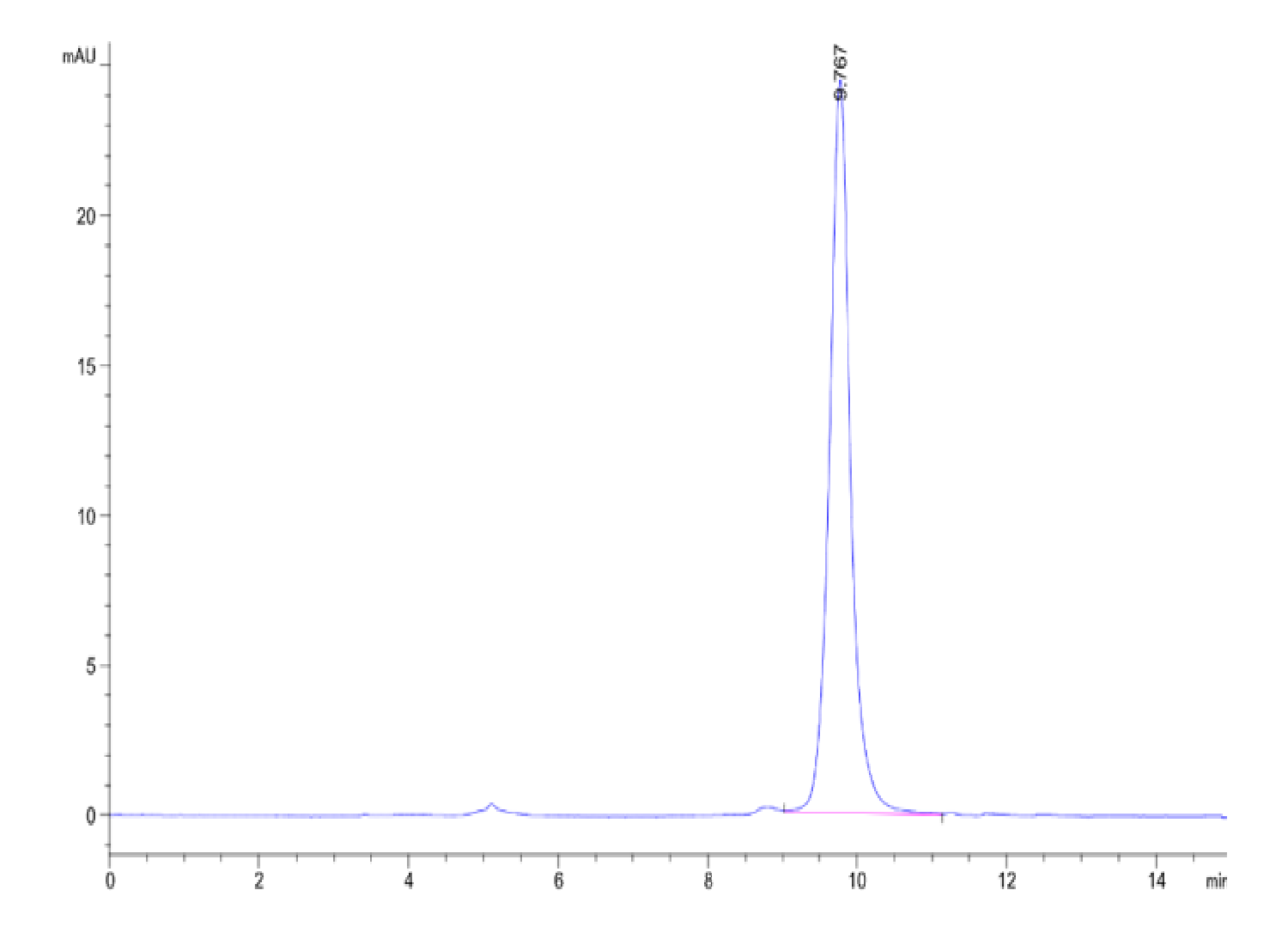| Weight | 1 lbs |
|---|---|
| Dimensions | 9 × 5 × 2 in |
| accession | NP_003659.2 |
| express system | Baculovirus-Insect Cells |
| product tag | C-Strep-II |
| purity | > 90% as determined by Tris-Bis PAGE;> 95% as determined by HPLC |
| background | The p38 mitogen-activated protein kinase (MAPK) pathway plays an important role in cellular responses to inflammatory stimuli and environmental stress. p38 regulated/activated protein kinase (PRAK, also known as mitogen-activated protein kinase activated protein kinase 5 [MAPKAPK5]) functions downstream of p38alpha and p38beta in mediating the signaling of the p38 pathway. |
| molecular weight | The protein has a predicted MW of 55.57 kDa. Due to glycosylation, the protein migrates to 35-45 kDa based on Tris-Bis PAGE result. |
| available size | 100 µg, 500 µg |
| endotoxin | Less than 1EU per μg by the LAL method. |
Human PRAK Protein 2324
$315.00 – $1,050.00
Summary
- Expression: Baculovirus-Insect Cells
- Pure: Yes (HPLC)
- Amino Acid Range: Met1-Gln471
Human PRAK Protein 2324
| protein |
|---|
| Size and concentration 100, 500µg and liquid |
| Form Liquid |
| Storage Instructions Valid for 12 months from date of receipt when stored at -80°C. Recommend to aliquot the protein into smaller quantities for optimal storage. Please minimize freeze-thaw cycles. |
| Storage buffer Shipped with dry ice. |
| Purity > 95% as determined by Tris-Bis PAGE |
| target relevance |
|---|
| The p38 mitogen-activated protein kinase (MAPK) pathway plays an important role in cellular responses to inflammatory stimuli and environmental stress. p38 regulated/activated protein kinase (PRAK, also known as mitogen-activated protein kinase activated protein kinase 5 [MAPKAPK5]) functions downstream of p38alpha and p38beta in mediating the signaling of the p38 pathway. |
| Protein names MAP kinase-activated protein kinase 5 (MAPK-activated protein kinase 5) (MAPKAP kinase 5) (MAPKAP-K5) (MAPKAPK-5) (MK-5) (MK5) (EC 2.7.11.1) (p38-regulated/activated protein kinase) (PRAK) |
| Protein family Protein kinase superfamily, CAMK Ser/Thr protein kinase family |
| Mass 54220Da |
| Function Tumor suppressor serine/threonine-protein kinase involved in mTORC1 signaling and post-transcriptional regulation. Phosphorylates FOXO3, ERK3/MAPK6, ERK4/MAPK4, HSP27/HSPB1, p53/TP53 and RHEB. Acts as a tumor suppressor by mediating Ras-induced senescence and phosphorylating p53/TP53. Involved in post-transcriptional regulation of MYC by mediating phosphorylation of FOXO3: phosphorylation of FOXO3 leads to promote nuclear localization of FOXO3, enabling expression of miR-34b and miR-34c, 2 post-transcriptional regulators of MYC that bind to the 3'UTR of MYC transcript and prevent MYC translation. Acts as a negative regulator of mTORC1 signaling by mediating phosphorylation and inhibition of RHEB. Part of the atypical MAPK signaling via its interaction with ERK3/MAPK6 or ERK4/MAPK4: the precise role of the complex formed with ERK3/MAPK6 or ERK4/MAPK4 is still unclear, but the complex follows a complex set of phosphorylation events: upon interaction with atypical MAPK (ERK3/MAPK6 or ERK4/MAPK4), ERK3/MAPK6 (or ERK4/MAPK4) is phosphorylated and then mediates phosphorylation and activation of MAPKAPK5, which in turn phosphorylates ERK3/MAPK6 (or ERK4/MAPK4). Mediates phosphorylation of HSP27/HSPB1 in response to PKA/PRKACA stimulation, inducing F-actin rearrangement. {ECO:0000269|PubMed:17254968, ECO:0000269|PubMed:17728103, ECO:0000269|PubMed:19166925, ECO:0000269|PubMed:21329882, ECO:0000269|PubMed:9628874}. |
| Catalytic activity CATALYTIC ACTIVITY: Reaction=ATP + L-seryl-[protein] = ADP + H(+) + O-phospho-L-seryl-[protein]; Xref=Rhea:RHEA:17989, Rhea:RHEA-COMP:9863, Rhea:RHEA-COMP:11604, ChEBI:CHEBI:15378, ChEBI:CHEBI:29999, ChEBI:CHEBI:30616, ChEBI:CHEBI:83421, ChEBI:CHEBI:456216; EC=2.7.11.1; CATALYTIC ACTIVITY: Reaction=ATP + L-threonyl-[protein] = ADP + H(+) + O-phospho-L-threonyl-[protein]; Xref=Rhea:RHEA:46608, Rhea:RHEA-COMP:11060, Rhea:RHEA-COMP:11605, ChEBI:CHEBI:15378, ChEBI:CHEBI:30013, ChEBI:CHEBI:30616, ChEBI:CHEBI:61977, ChEBI:CHEBI:456216; EC=2.7.11.1; |
| Subellular location Cytoplasm. Nucleus. Note=Translocates to the cytoplasm following phosphorylation and activation. Interaction with ERK3/MAPK6 or ERK4/MAPK4 and phosphorylation at Thr-182, activates the protein kinase activity, followed by translocation to the cytoplasm. Phosphorylation by PKA/PRKACA at Ser-115 also induces nuclear export. |
| Tissues Expressed ubiquitously. {ECO:0000269|PubMed:9628874}. |
| Structure Interacts with ERK3/MAPK6 and ERK4/MAPK4 (via FRIEDE motif); the interaction is direct (By similarity). Interacts with YWHAE; the interaction prevents phosphorylation of HSP27/HSPB1 leading to disrupt F-actin polymerization. Interacts with SQSTM1. {ECO:0000250, ECO:0000269|PubMed:10708586, ECO:0000269|PubMed:17728103}. |
| Post-translational modification Phosphorylated on Thr-182 ERK3/MAPK6 or ERK4/MAPK4; which is the regulatory phosphorylation site and is located on the T-loop/loop 12, leading to activation. Phosphorylation at Thr-182 by p38-alpha/MAPK14, p38-beta/MAPK11 is subject to debate. Phosphorylated at Ser-115 by PKA/PRKACA, leading to localization to the cytoplasm. Autophosphorylated (By similarity). {ECO:0000250}. |
| Target Relevance information above includes information from UniProt accession: Q8IW41 |
| The UniProt Consortium |
Data
 |
| The purity of Human PRAK is greater than 95% as determined by SEC-HPLC. |
 |
| Human PRAK on Tris-Bis PAGE under reduced condition. The purity is greater than 90%. |
Publications
Publications
| pmid | title | authors | citation |
|---|---|---|---|
| We haven't added any publications to our database yet. | |||
Protocols
| relevant to this product |
|---|
Documents
| # | ||
|---|---|---|
| Please enter your product and batch number here to retrieve product datasheet, SDS, and QC information. | ||














